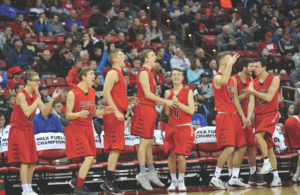Sport specialization: Risks, benefits and how coaches can guide athletes
Sport specialization has become a hot topic. At a time when professional athletes are idolized and college scholarships are coveted, some consider it the best way to gain proficiency in a single sport.
 All coaches should understand the benefits, risks and strategies of sport specialization to better educate athletes and parents who want to explore this option. While focusing on one sport can lead to greater proficiency, is the loss of participation in other sports and activities too detrimental to the development of young athletes?
All coaches should understand the benefits, risks and strategies of sport specialization to better educate athletes and parents who want to explore this option. While focusing on one sport can lead to greater proficiency, is the loss of participation in other sports and activities too detrimental to the development of young athletes?
Motivation to play
There are a number of reasons kids play sports. Some of the most common are to have fun, spend time with friends and to develop personal skills. Each athlete has their own reasons for participating, and understanding the reasons can help us understand why an athlete chooses to specialize.Probably the most common motivator for specialization is outside pressure. Parents, clubs, school coaches and teammates commonly have the greatest influence. If an athlete shows potential in a sport, specialization may be suggested as a means to develop proficiency. For athletes who have teammates that play year round for a club, they may feel pressured to join a club team to dedicate more time to friends and skill proficiency.
Many young athletes believe that an athletic scholarship is the only means by which they can attend college, and sport specialization will increase their odds. Financial constraints and the desire to play college sports are powerful motivators for athletes to become proficient and talented in a single sport. Young athletes often believe that if they are dividing time between two or three different sports, mastering skills in just one is difficult.
Benefits of specialization
Some research suggests that specialization helps to master techniques and advanced skills, both of which are commonly accepted as the only way to develop proficiency in a sport. Athletes participating in a sport year-round tend to master the skills faster than players who focus on other sports throughout the year. A one-sport athlete is guaranteed more repetitions, extended drill time and increased competition. These athletes receive more feedback from coaches and may have time to learn from that feedback.
Specializing also allows athletes to develop greater cognitive skills in a single sport through the increased exposure. When athletes play multiple sports, there is less time for specific cognitive and muscular control of movements. A sport that incorporates lateral movement utilizes cognitive and muscular control differently than those that heavily rely on vertical movement. Repetition of the movements that are specific to one sport allows the athlete to continue training and competing at a higher level.
An athlete who specializes must be dedicated to that sport year-round to remain competitive and continually develop skills. They must learn to fight through physical or mental fatigue, increasing their mental toughness. Specifically, an athlete that focuses on one sport can experience improved self-confidence in their sport, increased motivation, better concentration, and an improved ability to regulate emotions in that sport. For young athletes that are still maturing, these advantages can provide greater opportunities for success.
Examining the risks
As the number of repetitions of a single movement increases, the muscle groups performing the movement are at risk of acute, chronic and overuse injuries. Once an injury occurs, in many cases the risk for re-injury is higher. As injuries mount, athletes can lose the motivation to participate.
One of the greatest risks of specialization is mental and physical burnout. Boredom, staleness and overtraining often preclude burnout in an athlete, often from the increased number of training sessions and competitions. Reasons for burnout include:
- Parental pressure
- Excessive demands on the athlete
- Lack of fun
- Win-at-all-costs environments
- Perceived lack of growth in personal development
- Increased injuries
- Decreased rest/recovery time
Year-round sports also have been shown to lead to social development issues in young athletes. They can develop an inability to interact with peers outside the sport setting and refuse social support in stressful situations. They may want more time to dedicate to other activities where they can interact with other people.
Coaching specialized athletes
Once a young athlete decides to specialize, it’s up to the parents and coaches to ensure they follow a safe training regimen. To avoid the pitfalls of specialization, following a few strategies can maximize the benefits of specialization while minimizing the risks. Here are four recommendations:
1. Manage fatigue. It’s important for the athlete to be given appropriate rest between practices and competitions. A structured training regimen that balances physical and mental training with a full competition schedule will allow for proper rest.
Changing the focus on which organ systems (muscular, nervous and cardiovascular) are relied on more heavily during training sessions can lead to beneficial growth of these systems. Implementing imagery training and positive self-talk are strategies that can replace some physical with cognitive exposure. Use video analysis of the athlete for recovery and competitions to encourage mental growth and physical recovery.
2. Watch and listen. Coaches must observe and listen to their athletes about training and fatigue. If an athlete becomes sluggish, experiences a decline in performance, or begins to show emotional signs of concern, a recovery period may be necessary.
Understanding the signs of overtraining — increased soreness, fatigue, increased minor injuries — are critical to maintain a safe environment for specialized athletes. Overtraining and staleness are precursors to burnout, so identification of these symptoms are instrumental in positive athlete development.
3. Developing a plan. Prevent injuries with the same concept of preventing fatigue. Rotating training schedules and focusing on different goals allow fatigued muscle groups and joints time to recuperate. Implementing a daily stretching and relaxation regimen helps young athletes to improve their range of motion and prevent injury. Work with a certified strength and conditioning coach to assist in developing a year-long training plan that incorporates different goals, exercises, focuses and recovery days.
4. Take time off. While athletes may not be interested in playing other sports, there are plenty of activities in which they may become involved, reducing social concerns and burnout from specialization. Athletes may develop and foster friendships away from the team that they can rely on for support during stressful times in training or competition. Encourage athletes to experience a wide variety of events, including music, art, community service and school clubs.
If the coach has specific time set aside for these activities, athlete and parents are more likely to agree. If the coach does not plan for recovery time, athletes can be hesitant and feel guilty in taking time to do other things. Be an advocate of other experiences.
Specialization will remain a debated topic for years to come. While athletes should have the final say on specialization, it’s important they understand the advantages and risks making a decision. Coaches are in a unique position where their athletes may approach them for advice.
Being informed of the advantages and risks, and providing all available information to their athletes, is a responsibility no coach should take lightly. Discussing all possibilities with the athlete and their parents can lead to an informed decision that will benefit children in their athletic endeavors.
Jordan Donnelly is a second-year graduate student in the sport and fitness administration program at Winthrop University. Joni Boyd, PhD, CSCS, is an assistant professor of exercise science and the coaching minor advisor at Winthrop.




